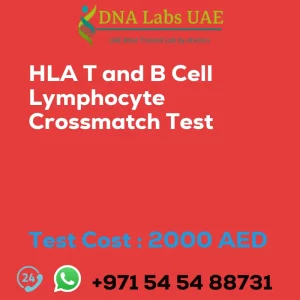HLA – PANEL REACTIVE IgG ANTIBODIES PRA CLASS II QUANTITATIVE Test
Test Cost: AED 2460.0
Symptoms: N/A
Diagnosis: N/A
Test Name: HLA – PANEL REACTIVE IgG ANTIBODIES PRA CLASS II QUANTITATIVE Test
Components: N/A
Price: 2460.0 AED
Sample Condition: 3 mL (1.5 mL min.) serum from 1 SST. Ship refrigerated or frozen. Collect specimen preferably 48 hours after dialysis. Provide brief clinical history.
Report Delivery: 10-12 days
Method: Luminex X-Map technology
Test Type: Transplantation
Doctor: Nephrologist, Gastroenterologist, Hematologist
Test Department: N/A
Pre Test Information: Collect specimen preferably 48 hours after dialysis. Provide brief clinical history.
Test Details:
The HLA Panel Reactive IgG Antibodies (PRA) Class II Quantitative test is a laboratory test used to assess the presence and quantity of IgG antibodies against human leukocyte antigens (HLA) in a patient’s blood. HLA molecules are proteins found on the surface of cells that play a critical role in the immune system’s recognition of self and non-self cells. These molecules are highly polymorphic, meaning they can vary between individuals.
When a patient receives an organ or tissue transplant, the recipient’s immune system may recognize the HLA molecules on the transplanted cells as foreign and mount an immune response, leading to rejection of the transplant. The PRA Class II test specifically measures the presence and quantity of IgG antibodies against HLA Class II molecules. Class II HLA molecules are primarily expressed on immune cells, such as B cells, dendritic cells, and macrophages.
By quantifying the level of IgG antibodies against HLA Class II, the test can provide information about the patient’s level of sensitization to potential donor organs or tissues. The test is typically performed prior to organ transplantation to determine the level of pre-existing antibodies against HLA Class II in the recipient. A higher PRA value indicates a higher level of sensitization, meaning the patient has a greater likelihood of having pre-existing antibodies that may react with potential donor organs.
This information is important in determining the compatibility between the recipient and potential donors, as a high PRA value may limit the number of suitable donor options.
In summary, the HLA Panel Reactive IgG Antibodies (PRA) Class II Quantitative test is used to measure the level of IgG antibodies against HLA Class II molecules in a patient’s blood. It provides valuable information about the patient’s level of sensitization and helps in determining the compatibility between the recipient and potential organ donors.
| Test Name | HLA – PANEL REACTIVE IgG ANTIBODIES PRA CLASS II QUANTITATIVE Test |
|---|---|
| Components | |
| Price | 2460.0 AED |
| Sample Condition | 3 mL (1.5 mL min.) serum from 1 SST. Ship refrigerated or frozen. Collect specimen preferably 48 hours after dialysis. Provide brief clinical history. |
| Report Delivery | 10-12 days |
| Method | Luminex X-Map technology |
| Test type | Transplantation |
| Doctor | Nephrologist, Gastroenterologist, Hematologist |
| Test Department: | |
| Pre Test Information | Collect specimen preferably 48 hours after dialysis. Provide brief clinical history. |
| Test Details |
The HLA Panel Reactive IgG Antibodies (PRA) Class II Quantitative test is a laboratory test used to assess the presence and quantity of IgG antibodies against human leukocyte antigens (HLA) in a patient’s blood. HLA molecules are proteins found on the surface of cells that play a critical role in the immune system’s recognition of self and non-self cells. These molecules are highly polymorphic, meaning they can vary between individuals. When a patient receives an organ or tissue transplant, the recipient’s immune system may recognize the HLA molecules on the transplanted cells as foreign and mount an immune response, leading to rejection of the transplant. The PRA Class II test specifically measures the presence and quantity of IgG antibodies against HLA Class II molecules. Class II HLA molecules are primarily expressed on immune cells, such as B cells, dendritic cells, and macrophages. By quantifying the level of IgG antibodies against HLA Class II, the test can provide information about the patient’s level of sensitization to potential donor organs or tissues. The test is typically performed prior to organ transplantation to determine the level of pre-existing antibodies against HLA Class II in the recipient. A higher PRA value indicates a higher level of sensitization, meaning the patient has a greater likelihood of having pre-existing antibodies that may react with potential donor organs. This information is important in determining the compatibility between the recipient and potential donors, as a high PRA value may limit the number of suitable donor options. In summary, the HLA Panel Reactive IgG Antibodies (PRA) Class II Quantitative test is used to measure the level of IgG antibodies against HLA Class II molecules in a patient’s blood. It provides valuable information about the patient’s level of sensitization and helps in determining the compatibility between the recipient and potential organ donors. |








